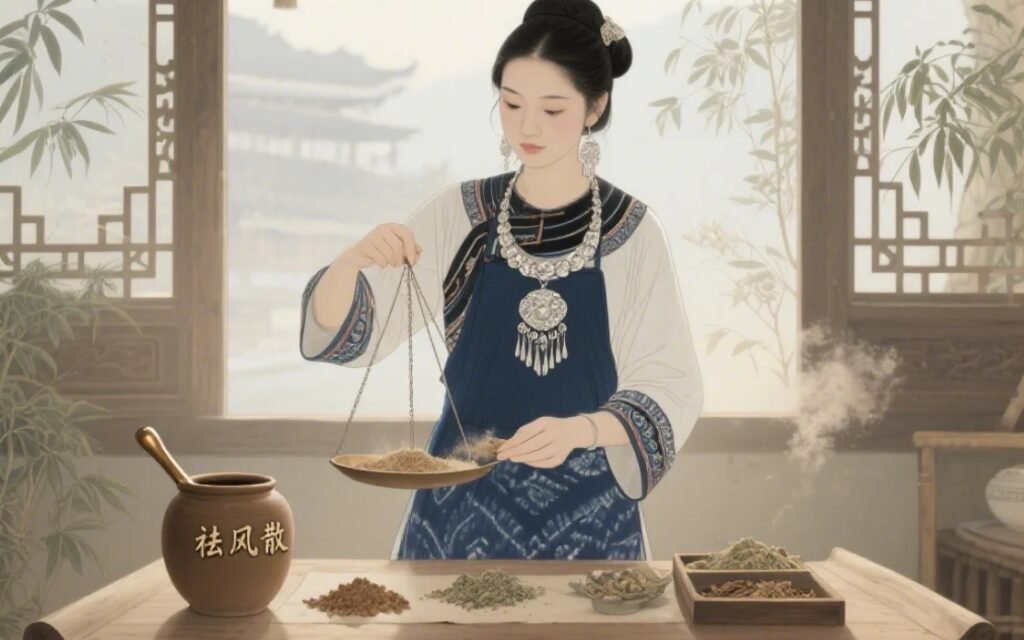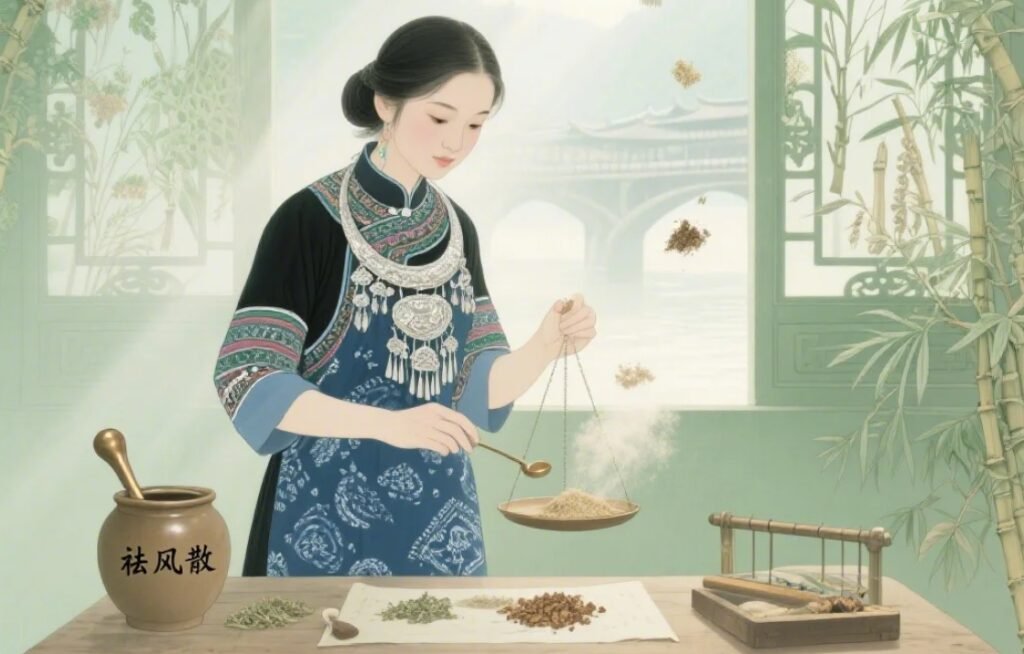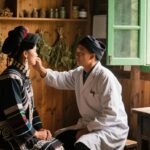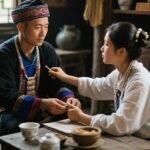Pugaqiu (Abdominal Distension and Ascites)
[Overview]
In Miao medicine, abdominal distension and ascites are called Pugaqiu, also known as Gaqiushusu Nuo, Hulejiong Gou, and Maoxiang Wu. The disease results from irregular diet, excessive alcohol consumption, emotional distress, overexertion, or parasitic infection. It is primarily characterized by abdominal swelling and tension like a drum, sallow facial complexion, prominent abdominal veins, reduced urination, poor appetite, lumps under the ribs or in the abdomen, and emaciated limbs.
In Traditional Chinese Medicine (TCM), this syndrome is attributed to emotional injury, dietary excess, schistosomiasis infection, or the chronic persistence of jaundice, hypochondriac pain, and abdominal masses. These conditions lead to liver qi stagnation, qi and blood stasis, and retention of dampness. The hallmark symptoms include drum-like abdominal distension, sallow skin tone, visible abdominal veins, subcostal or abdominal lumps, and progressive emaciation.
In Western medicine, conditions such as cirrhotic ascites, schistosomiasis, intra-abdominal malignancies, and tuberculous peritonitis can be referred to this section for pattern differentiation and (used in traditional contexts).
[Huhoujipeng · Miao Medicine Disease Classification]
This condition is considered one of the major diseases and is classified into two minor types: Heat Meridian Water-Ascites and Cold Meridian Water-Ascites.

[Aiduojiao · Etiology]
According to Miao medicine, Pugaqiu arises due to dietary imbalance, emotional disturbance, parasitic infection, chronic unresolved illness, and stagnation of pathogenic qi, leading to liver qi stagnation, qi and blood stasis, and internal accumulation of dampness in the abdomen. Emotional constraint causes liver qi stagnation, which impairs qi movement and blood circulation. As the liver qi overacts on the spleen, spleen transport fails, and water-dampness is not transformed. The interaction of qi stagnation and blood stasis leads to water accumulation in the abdomen.
Excessive alcohol damages the spleen and stomach, disrupting their transformative function. Alcohol and damp-heat accumulate in the middle jiao, obstructing qi movement, and resulting in water retention. Schistosomiasis or trauma damages the liver and spleen: impaired liver causes qi stagnation, damaged spleen leads to dampness accumulation, and worm obstruction injures the blood vessels. Qi, blood, and fluids become interlocked and stagnant, forming Pugaqiu.
Chronic jaundice, hypochondriac pain, or unresolved abdominal masses can also impair the liver and spleen. This disrupts the transformation of qi, blood, and fluids, causing abdominal retention and ultimately resulting in drum-like distension.
[Gengduomeng · Pathogenesis]
Untreated or persistent jaundice, hypochondriac pain, or abdominal masses, emotional disturbances, dietary indulgence, and schistosomiasis infection contribute to liver-spleen damage. Spleen dysfunction leads to damp accumulation in the abdomen, causing drum-like distension. Liver qi constraint and qi stagnation block the hepatic vessels, revealing visible abdominal veins. The combined effects of qi stagnation, blood stasis, and water retention over time develop into this condition.
[Diagnostic Key Points]
Diagnostic Criteria
(1) Early-stage symptoms include abdominal distension and pain that worsen after eating, progressing to gradual abdominal enlargement, with sallow complexion, fatigue, poor appetite. Over time, prominent abdominal veins, emaciated limbs, or lower limb edema appear, often accompanied by dysuria and bleeding tendencies.
(2) Masses under the ribs or in the abdomen, abdominal fluid wave, jaundice, palmar erythema, and spider angiomas on the face, neck, or chest. History may include dietary irregularities, emotional disturbances, exposure to external pathogens, trauma, or schistosomiasis infection.
Related Examinations
Abdominal ultrasound can assess ascites volume. Infectious markers help identify viral causes. Stool exams may reveal schistosome eggs or miracidia. Serological tests aid diagnosis of schistosomal cirrhosis. Liver function tests, abdominal CT/MRI, laparoscopy, and liver biopsy help differentiate causes of ascites. Paracentesis distinguishes transudate from exudate. Cytological and biochemical analysis of ascitic fluid assists diagnosis and differential diagnosis.
[Differential Diagnosis]
Puluopu Bi · Eb Nix (Water Bloating)
Both conditions involve edema of the limbs due to impaired lung diffusion and spleen transport, showing symptoms like abdominal distension, poor appetite, emaciation, and generalized edema. Puluopu Bi is often caused by external pathogenic invasion, contaminated food, congenital deficiency, chronic illness, or overwork, leading to lung and spleen dysfunction. It mainly features facial and limb edema, which in severe cases can progress into Pugaqiu.
Pugaqiu originates from unresolved jaundice, hypochondriac pain, abdominal masses, emotional distress, dietary excess, trauma, or schistosomiasis, leading to liver-spleen damage, qi stagnation, blood stasis, and water retention. It starts with abdominal pain and bloating worsened after meals, followed by gradual abdominal distension, sallow complexion, fatigue, and prominent abdominal veins, with limb emaciation or edema, and potential dysuria and bleeding.
[Syndrome Classification and Treatment]
Heat Meridian Water-Ascites
Mengli Duo (Symptoms): Dark complexion, fever, dry mouth and bitter taste, dizziness, fatigue, poor appetite, emaciation, abdominal distension with prominent veins, drum-like belly, lower limb edema, gum bleeding, scanty urination.
Xing Leng (Meridian Type): Heat meridian syndrome.
Jiahe Meng (Therapeutic Principle): Promote qi circulation and resolve stasis (hang ben diu xiang), drain dampness (wa wo).
Ou Duo Xijia, Gangou (Prescription and Analysis):

Decoction.
Jin Qian Cao: cold nature, bitter, sour, and astringent; clears heat and detoxifies, promotes urination, disperses stasis.
Che Qian Cao: cold, bitter and astringent; promotes urination, cools blood, clears heat.
Bai Mao Gen: cold, sweet and bitter; promotes diuresis and reduces dampness.
Shi Wei: cold and bitter; clears heat, detoxifies, drains dampness.
Tian Ji Huang: cold and bitter; clears heat, detoxifies, reduces swelling, promotes blood circulation.
Hei Chou, Bai Chou: cold, bitter and pungent, toxic; tonifies kidney, drains dampness.
Cold Meridian Water-Ascites
Mengli Duo (Symptoms): Drum-like abdominal distension, poor appetite, lower limb edema, scanty urination, dyspnea, inability to lie flat, aversion to cold, curled posture, constipation.
Xing Leng (Meridian Type): Cold meridian syndrome.
Jiahe Meng (Therapeutic Principle): Purgation and diuresis (she ga wa wo).
Ou Duo Xijia, Gangou (Prescription and Analysis):
Decoction.
Ma Bian Cao: cold, bitter and astringent; clears heat, reduces dampness, promotes blood circulation, reduces swelling.
Ban Bian Lian: neutral, pungent; clears heat, detoxifies, reduces edema.
Chuan Po Shi: neutral, bland, slightly bitter; drains dampness, clears heat, unblocks channels, detoxifies.
Ma Bian Cao (Verbena, ma bian cao) 30g
Ban Bian Lian (Lobelia, ban bian lian) 30g
Chuan Po Shi (Saxifraga stolonifera, chuan po shi) 30g
Jin Qian Cao (Lysimachia, jin qian cao) 20g
Che Qian Cao (Plantago herb, che qian cao) 15g
Bai Mao Gen (Imperata root, bai mao gen) 20g
Shi Wei (Pyrrosia leaf, shi wei) 12g
Tian Ji Huang (Hypericum japonicum, tian ji huang) 12g
Hei Chou, Bai Chou (Aristolochia debilis and Ampelopsis, hei chou, bai chou) 10g each
[Prevention and Care]
Regulate emotions, avoid excessive worry; avoid cold drafts and maintain proper warmth; follow a balanced diet and avoid smoking and alcohol.
Maintain proper lifestyle balance with regular rest and activity.
[Remarks]
Miao medicine believes qi, blood, and water are the three fundamental substances constituting the human body, essential to life and health. “Jiao Ben” refers to qi, the subtle energy that sustains life and expresses bodily vitality; “Xing” refers to blood, the refined essence derived from food to nourish the body; “Wo” refers to water, the indispensable foundational substance of the body. These three mutually depend and influence each other. Pugaqiu occurs due to dysfunction of the liver, spleen, and kidneys, resulting in impaired movement of qi, blood, and water, leading to stagnation and accumulation. Treatment focuses on promoting qi movement, resolving stasis, strengthening the spleen, and promoting diuresis. In cases with severe ascites and dual deficiency of spleen and kidney, tonifying spleen and warming kidney, nourishing liver and kidney are used.


Leave a Reply